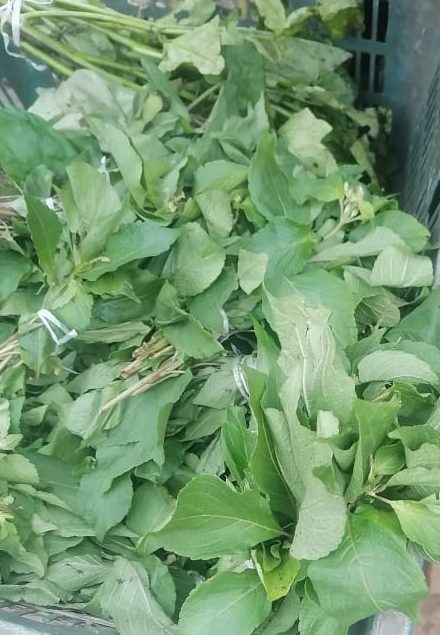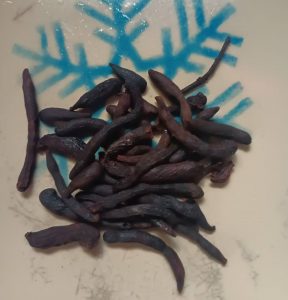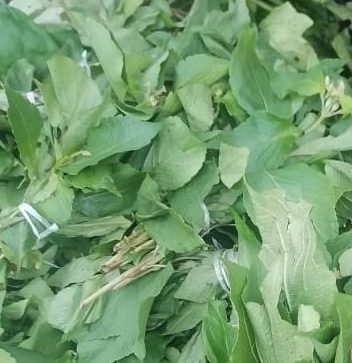Spices are products of the plant which are mostly for seasoning and thus enhance the taste of foods, beverages fruit, roots, bark, or vegetable substances. Spices have been known and used in different parts of the world by many countries.
The use and cultivation of spice plants date back to the beginning of history and most of the spices that are valued today were known for ancient utilization by the people of Egypt, Greece, China, Rome, and East India.
In Nigeria, many spices are collected from the wild. Examples are Uziza (piper guineese) and soft Scent leaf (Ocimum gratissimum) which are usually dried for use to give flavour and aroma. According to Simeon Chituru Achinewhu, a Nigerian food and nutrition biochemist, these spices are often referred to as food accessories of adjustment because of their ability to stimulate and increase the flow of gastric juice in the body system.
SCENT LEAF

Scent leaf is known as Ocimum grattisimum which is a small shrub with many branches and is commonly found around village houses and gardens. The leaves have an aromatic scent and make up a substantial portion of vitamins and vegetables which are needed for human health and also livestocks
DESCRIPTION / ORIGIN OF SCENT LEAF (OCIMUM GRATISSIMUM)
The use of plant materials as spices, condiments, and for medicinal purposes dates back to the early history of mankind. Recently, the exploitation of wild plants for medicinal purposes has gained more acceptance in many countries in Africa and the world at large.
To further emphasize the importance of herbal medicine, many national governments have established a traditional medicine regulatory council. Their various health ministries are exploring the numerous potentials of herbs. This may be because traditional medicine has long been used even before orthodox medical practice appeared.
The plant is an erect small shrub with many branches and is usually not more than 1 m high. It is of the family Labiatae, genus Ocimum, and species gratissimum. In Southeast Asia, it is cultivated as a home garden crop, but it is grown on a commercial scale in Vietnam.
In Nigeria, it is Efinrin in Yoruba, Diadoyal in Hausa, and Nchuanwu in Igbo. It has a variety of uses. Culinarily, it is used in salads, soups, pasta, vinegar, and jellies in many parts of the world. The Thai people regularly use it in food flavouring.
In traditional medicine, the leaves have been used as a general tonic and antidiarrhea agent. They have been used for the treatment of conjunctivitis by instilling directly into the eyes. The leaf oil, when mixed with alcohol, is applied as a lotion for skin infections and taken internally for bronchitis and The dried leaves are inhaled to alleviate headaches and fever, amongst other uses.
It is argued by many that conventional antibiotics, used in orthodox medicine but they do not combine well with herbal extracts as one normally antagonises the activity of the other.
RELATED ARTICLES:
– Bambara Groundnut, Uses And Health Importance
– disadvantages of tiger nut; health complications and Health importance of tiger nuts;
– How To Make Homemade Cookies Made From Composite Flour (Wheat And Sesame)
MEDICINAL USES OF SCENT LEAF
1. Scent leaf has been used extensively in the traditional system of medicine in many countries. In the Northeast of Brazil, it is used for medicinal, condiment, and culinary purposes. According to Healthline, the flowers and the leaves of this plant are rich in essential oil, so it is used in the preparation of teas and infusions.
2. In the Coastal areas of Nigeria, the plant is used in the treatment of epilepsy, high fever, and diarrhea. In the Savannah areas, decoctions of the leaves are utilised to treat mental illness. Scent leaf is used by the Igbos of Southeastern Nigeria in the management of the baby’s cord, to keep the wound surfaces sterile.
3. It is also used in the treatment of fungal infections, colds, and catarrh. Brazilian tropical forest inhabitants used a decoction of scent leaf roots as a sedative for children. People of Kenya and Sub-Saharan Africa used it in the treatment of abdominal pains, sore eyes, infections, coughs, barrenness, fever, convulsions and mouth gargling, regulation of menstruation and as a treatment for prolapsed rectum.
4. In India, the whole plant has been used for the treatment of sunstroke, headache, and influenza, as a diaphoretic, antipyretic, and for its anti-inflammatory activities. The tribes of Nigeria use the leaf extract in the treatment of diarrhea, while the cold leaf infusions are used for the relief of stomach upset and haemorrhoids.
5. The plant is commonly used in folk medicine to treat different diseases such as upper respiratory tract infections, diarrhea, headache, disease of the eye, skin diseases, pneumonia, cough, fever, and conjunctivitis. The infusion of O. gratissimum leaves is used as an antiseptic pulmonary antisepticum, cold medicine and antispasmodic.
PIPER GUINEENSE (UZIZA)

This is a spice plant from the family piper aceae and the genus piper. It is a West African spice plant commonly called Uziza in Igbo and iyere in Yoruba. The plants that provide Uziza are vines that grow up to 20m tall climbing up the bole of trees using adventitious roots.
It is a perennial plant that is characterised by heart-shaped leaves and oval, petiole, alternate, 12cm long. The leaves have a peppery taste, are pale greenish colour when fresh and darker green when frozen or dried. They are used as a flavouring for stews. The inflorescence is a pedicel flower spike between 3 and 6cm long and the peduncle 5mm long. Flowers are greenish yellow and arranged in a spiral along the spine.
The plant is native to tropical regions of Central and Western Africa and is semi-cultivated in countries like Nigeria where it is found commonly in the southern part where it grows in the evergreen rainforest and forest edges, usually in wet places, or along rocky rivers at a height of 750-1,650m.

USES AND BENEFITS OF UZIZA
1. It is used in West African cuisine where it impacts heat and a spicy pungent aroma to West African soup, rice, and stew.
2. The oil distilled from Uziza is used in perfume and soap making. In some parts of Nigeria, seeds are consumed by a woman after childbirth to enhance uterine contraction, therefore adding fast return of uterine muscle to the original shape. It is also used as an anti-asthmatic, for the control of weight and as an aphrodisiac. The seeds of Uziza are used to relieve discomfort in the stomach caused by excess gas.
3. Piper guineense also has preservative and antioxidant properties attributed to the phytochemicals, flavonoids, saponins, tannins, and alkaloids which have been found to have antimicrobial properties.
4. Uziza has aphrodisiac properties said to increase sexual behaviour. It was also found to be effective in the management of cancer. Piper guineense has larvicidal effects at high concentrations on mosquito larvae with 90% and 80% mortality at 100mg/ml respectively. This could be attributed to the phytochemicals present in the plant extracts.
5. The more concentrated the plant extract is the more larvicidal effect. Hence this plant could be utilised in the production of botanical larvicides which could be used as a substitute for the synthetic ones, as they are readily available, eco-friendly and biodegradable. Pipe guineense also has anti fungal effect.
You may also like to read our recent article How To Prepare Cake With Passionfruit, Lemon, Lime and Tigernut

Pingback: Infection Cleansing drink from local roots and herbs, Detox Drink
Pingback: Bitter leaf; health importance
Pingback: How to Prepare Bitter Leaf Drink
Pingback: Recipe for an Herbal Cleansing Drink